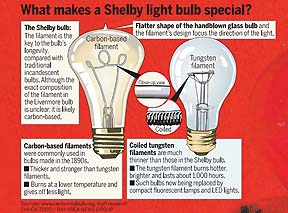|
About a year ago Professor Debora M. Katz of Annapolis Physics
Dept. signed the guestbook, and after some e-mails I sent her
a 30W Shelby Bulb, the same vintage and make as our Centennial
Bulb. The reason was she has the facilities to test the bulb
in ways we could never attempt with big brother.
I put a few questions to her about filament size, (to dispell
the myth of it being pencil thickness), the actual heat by means
of a temperature coeeficient test, and an analysis of the 100
year old gases inside.
2008
Dr. Katz had this to say about the results;
"I
found the width of the filament. I compared it to the width of
a modern bulb's filament. It turns out that a modern bulb's filament
is a coil, of about 0.08 mm diameter, made up of a coiled wire
about 0.01 mm thick. I didn't know that until I looked under
a microscope. The width of the Shelby bulb's 100 year old filament
is about the same as the width of the coiled modern bulb's filament,
0.08 mm.
We didn’t want to break the Shelby
bulb so we used the laser."
For comparrison the thickness of a human hair is approximately
0.06-0.09 mm.
Below are some pictures of the experiment using the laser.
When asked if the thickness could attribute to the longevity
she replied,
"I don't have a clear answer.
I think the thickness may make a difference. I wonder if the
filament does not get as hot. I think I would like to see if
I can get the spectrum."
|
Thank you Professor Katz, for your time and skills
in answering our puzzling questions. We look forward to your
next tests!
(Please click thumbnails to enlarge) |
Nov. 2009
In 2010 Dr. Katz assigned a grad student, Ensign Justin Felgar,
to continue with the tests on a working 30W Useful Light bulb.
Here is Dr. Katz's explanations of the pictures;
1&2. Two multimeters. One for measuring current, the other
for voltage
3. Variac to control voltage to bulb.
4. Bulb in socket
5. Using an ommeter to measure resistance of the filament at
room temperature.
6 & 8. Showing the software used to measure bulb's spectrum
7. Close up showing sensor used to measure spectrum
9. Two multimeters. One for measuring current, the other for
voltage
10. Close up showing sensor used to measure spectrum
11&12.
Showing the bulb at 80V and 120V
Thank you Professor Katz, for your time and skills
in answering our puzzling questions. We look forward to your
next tests!
(Please click thumbnails to enlarge)
At the completion of these tests, and other research,
Ensign Justin Felgar wrote a great paper on Shelby bulbs. Please
follow this link to his published
paper, in pdf form. He did an amazing job. Fantastic! |

2011 Interview
|
“It struck me as almost ridiculous that this 100-yearold
technology is still functioning. I thought for sure that all
the physics must have been worked out,” said Debora Katz,
a U.S. Naval Academy physics professor who first learned about
the bulb when it was featured on the “Mythbusters”
television show. Intrigued, she sent her students to dig up Chaillet’s
patent. Its contents were disappointing: Only the configuration
of the filament and the shape of the handblown glass he used
in an effort to reduce light refraction and better direct the
bulb’s light were described. Information that might have
shed light on his bulb’s life span, such as the
composition of its fi lament and the gas surrounding it, were
absent.
Livermore’s bulb can’t be tested directly for fear
of destroying it, Katz said. Still, experiments conducted on
identical Chaillet bulbs might
hold clues. To determine its thickness, Katz’s team shined
a laser on a Shelby filament and measured the pattern produced
on a screen behind
the bulb. The results showed Chaillet’s filament was eight
times thicker than that of a modern bulb. Another difference
is wattage. Modern household bulbs range from 40 to 200 watts
— the Centennial bulb
now gives off 4 watts, about as strong as a night light. Thought
to have been a 30-watt bulb when installed, the Livermore light
seems to have decreased in power over time.
“You can think of it as sort of an animal with a low metabolism.
It’s giving us less energy per time, so it can keep on going
longer,” Katz
said. Other data add credence to the reports that the Centennial
Light filament was carbon-based — the norm before tungsten
filaments were introduced in the early 1900s. The results are
documented
in “The Centennial Light Filament,” a 2010 paper by
one of Katz’s former students.
Author Justin Felgar found the hotter the Shelby got, the more
electricity got through it. The opposite is true for modern tungsten
filaments, suggesting the Shelby fi lament is made of something
else. To determine its makeup, Katz said she wants to rip apart
a Shelby bulb that isn’t functioning and run its filament
through the Naval Academy’s particle accelerator —
hopefully before the Centennial Light’s 110th birthday in
June. “Perhaps there’s just some fluke with that particular
(bulb),” Katz said, adding, “I think we should at least
be able to talk about what the
differences are between the Shelby bulb and the contemporary
bulb. Whether those differences account for longevity, I don’t
know.”
To see the full article go to Page1
or Page 7. |
|
